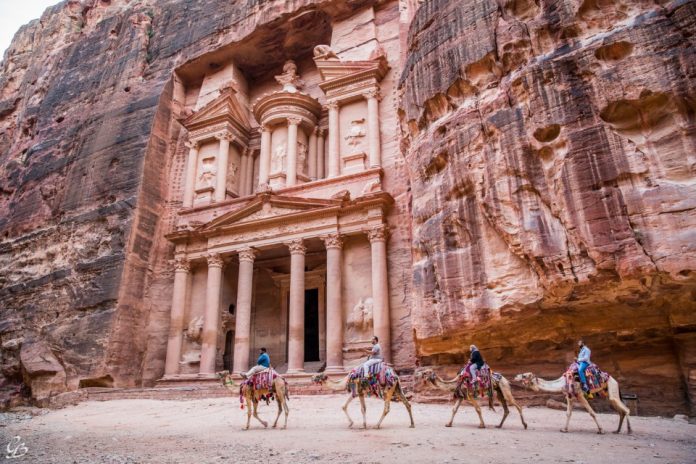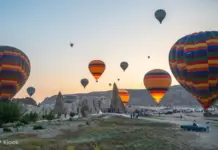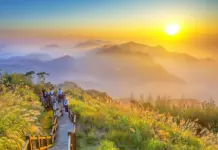If I had only one word to describe Jordan, it would be ‘sand’. Sand in its all shapes and colors. Sand blows in the wind along the Jordan River valley, deposited in mineral mud at the bottom of the Dead Sea, forming red sandstone in mysterious rocky deserts. Those sandstone blocks ‘gave birth’ to a wonder of the world: Petra. The ancient city of Petra is the jewel of Jordan and has been recognized by UNESCO as a World Heritage Site since 1985. So, is Petra worth visiting, how to visit Petra, how to go to Petra, what to do in Petra Jordan, and how to plan a perfect budget trip to Petra Jordan for the first-time? Let’s check out our Petra blog (Petra Jordan travel blog) with the fullest Petra Jordan travel guide (Petra guide, Petra tourist guide, Petra travel guide) from how to get to Petra Jordan, how to go to Petra Jordan, where to stay, best places to visit, what to eat and top things to do in Petra as well as suggested 2 days in Petra (Petra itinerary 2 days, Petra Jordan itinerary) to find out the answer!
- What to buy in Jordan? — +13 best souvenirs, gifts & top things to buy in Jordan
- Jordan travel blog — The fullest Jordan travel guide & suggested Jordan itinerary for first-timers
- The ULTIMATE Uji travel guide: Top attractions, best things to do in Uji Kyoto, Tips & MORE
- Kyoto itinerary 5 days: How to spend 5 days in kyoto perfectly?
- Where to visit in Queenstown: 15 must see & best places to visit in Queenstown
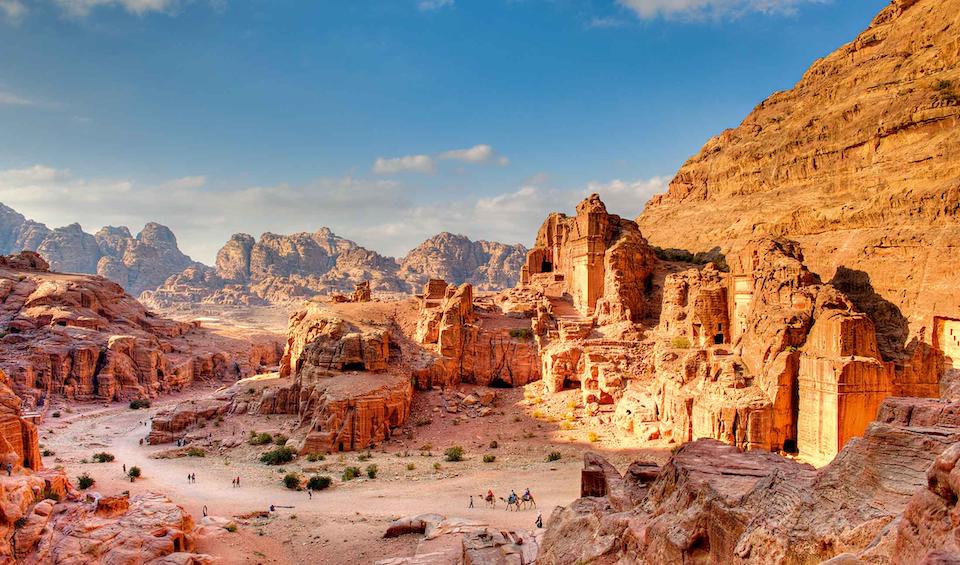
Before setting foot in this Middle Eastern country of Jordan, I never thought I would give so much love to this place. But every grain of sand of that land stained with the past ten thousand years has held my heart. It exudes a deep, slow charm that makes us fall in love, slowly capture our heart by its own beauty without even realizing it.
Petra blog: The Petra of the past
Petra means “rock, stone” in Greek. In the ancient Semitic language of the Middle East, Petra was called Raqmu – “multicolored”. The name is so true to this place. The already beautiful red-pink sandstone layer is also decorated by nature with blue, yellow, white, black, winding and layered lines, intricate and super beautiful.
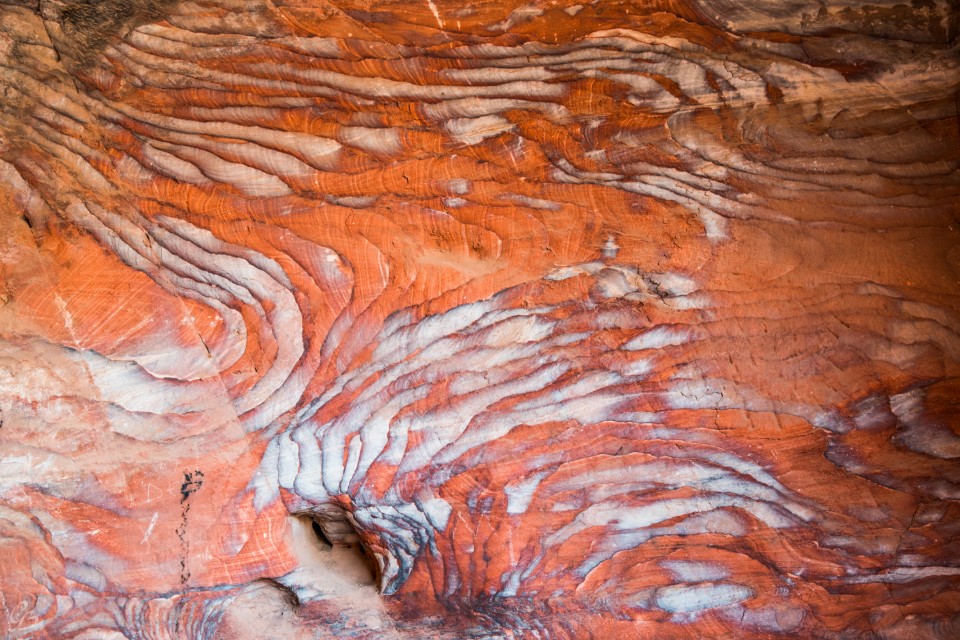
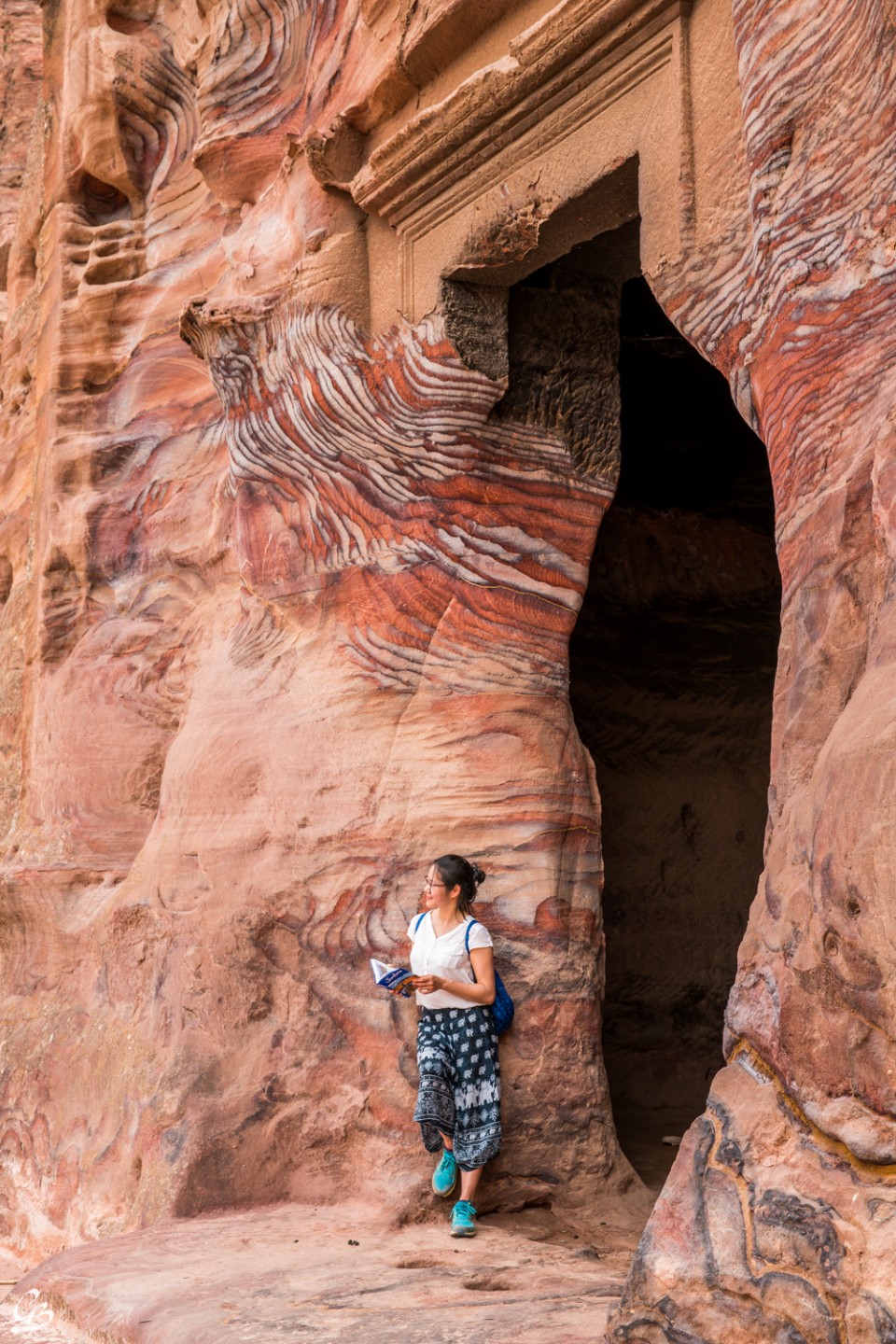
No one knows how and when Petra was found. We only know this land is located in a prime location for trading, located on the trade route connecting West Asia and ancient Egypt. So, the Nabateans chose it as their capital, and the city began to flourish in the centuries before and after AD. The Nabateans were an ancient nomadic Arab people who lived by trade. They were both irrigation engineers and talented architects. My dream of going to Petra was also sparked from watching a documentary about irrigation works in this ancient city.
Contrary to what I had imagined, Petra was very large, spread over tens of square kilometers. In its heyday, the Nabateans built a bustling city, with big roads and great buildings: Theaters, tombs, temples… surrounded by fertile fields and gardens, irrigated by a sophisticated system of canals, dams and reservoirs. The ancient Nabateans knew how to master water resources and dominate the arid desert like Jordan.
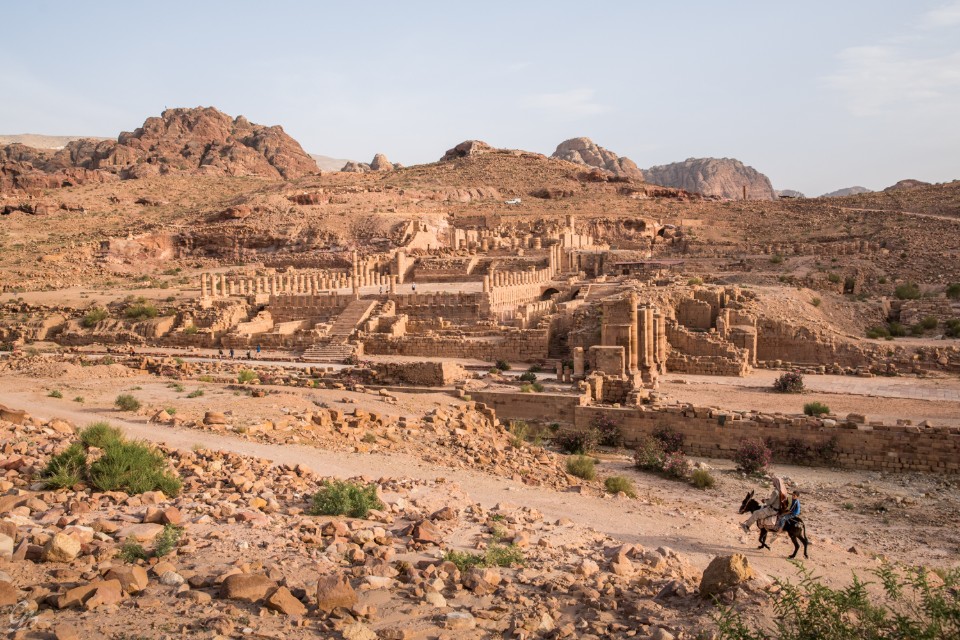
For hundreds of years, Petra continued to grow and flourish after being incorporated into the empire of the Romans, who were also engineering and architectural geniuses. Until between the 4th and 7th centuries AD, strong earthquakes destroyed much of the city. And Petra gradually fell into oblivion.
The first greeting
Today, although it is crowded with tourists, perhaps the wildness and silence of the desert still dominate, overwhelms the flow of people who flock here every day. Therefore, Petra is spacious and comfortable, not crowded like other wonders of the world. I was greedy to find myself a completely quiet Petra. So, every morning during my trip, I always woke up early, queue at the ticket gate from 6 am, then spent the day carrying my backpack wandering around the trekking trails between the rocky mountains and the desert.
Siq, the entrance to Petra, 1.2 km long, with some sections are only about 2 meters wide, leads us into the ancient city. Siq is a narrow canyon, formed between massifs over 200 meters high that were split in half during seismic activity, then honed by overflowing river water and strong winds. Around AD 50, the Nabateans, in the process of developing Petra, built a large dam, channeling the Wadi Musa River, preventing it from flowing through Siq towards Wadi Mujib and Wadi Al Mataha. Siq has since become the most natural, sacred, and most wonderful gateway a city can dream of having. But then the earthquakes that destroyed the ancient Petra also damaged the ancient dam. The water in Wadi Musa valley flooded into Siq again. Nature recaptured Petra. The entrance to the city completely disappeared until the end of the 20th century, when a new dam was rebuilt according to the original.
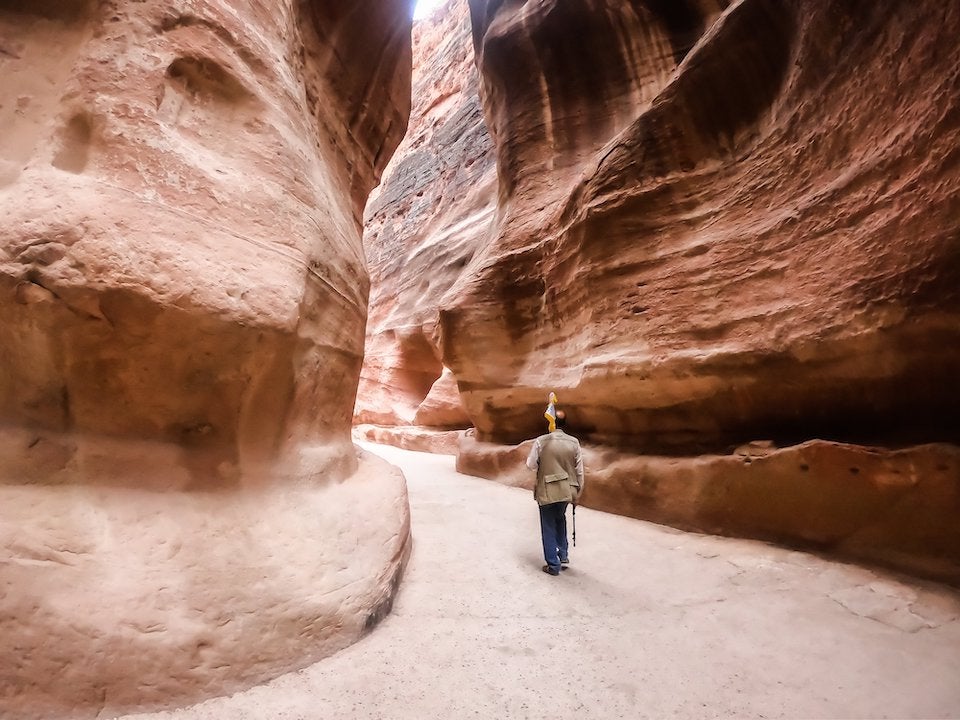
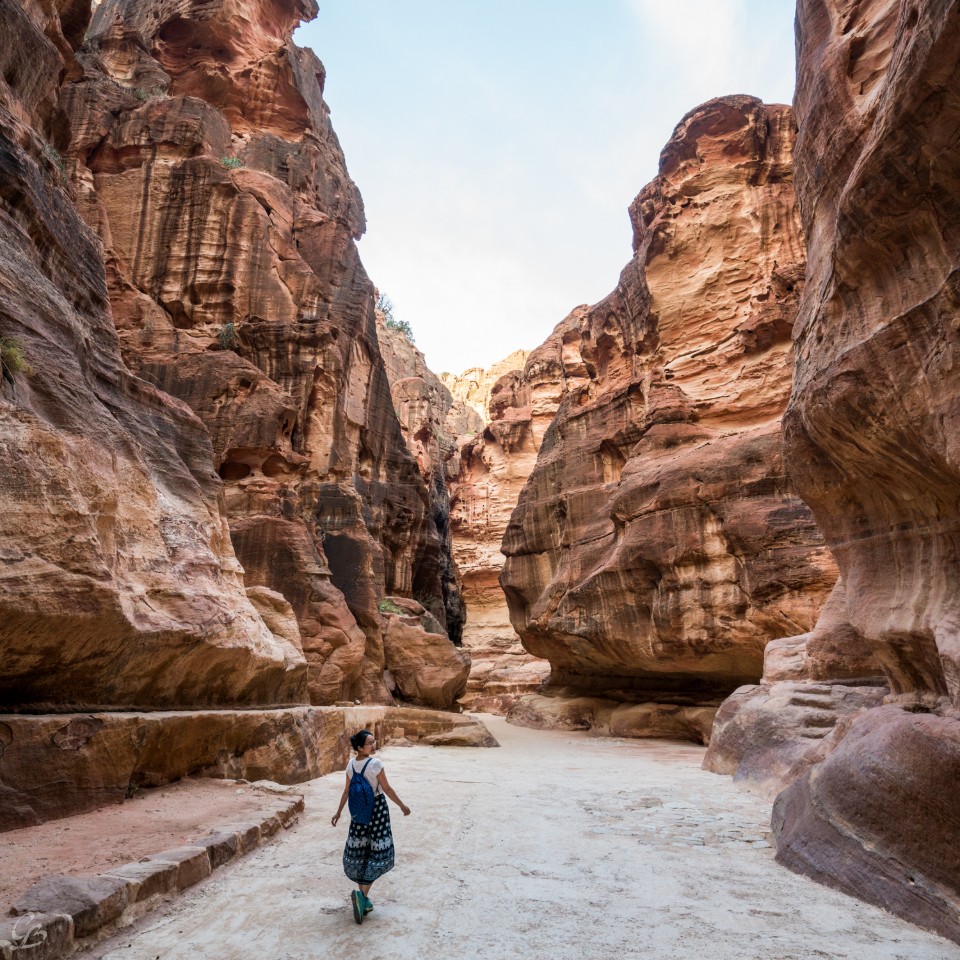
In the early morning, Siq was completely quiet. Only the sound of footsteps echoed on the natural crushed stone floor, echoing up two high cliffs. The narrow and quiet road, completely in the shadow of the steep stone walls, leads us into the sleeping city. At that moment, the purple-pink mountain silhouette suddenly burst into the sunlight right in front of one of the wonders of Petra, the symbol of Jordan: The Treasury, or Al-Khazneh in Arabic, which means «treasury». The name was given by the Bedouins, the sole inhabitants of Petra and descendants of the ancient Nabateans. They once believed in the legend that Al-Khazneh was the place where the pharaoh in the biblical of Exodus hid a treasure of gold.
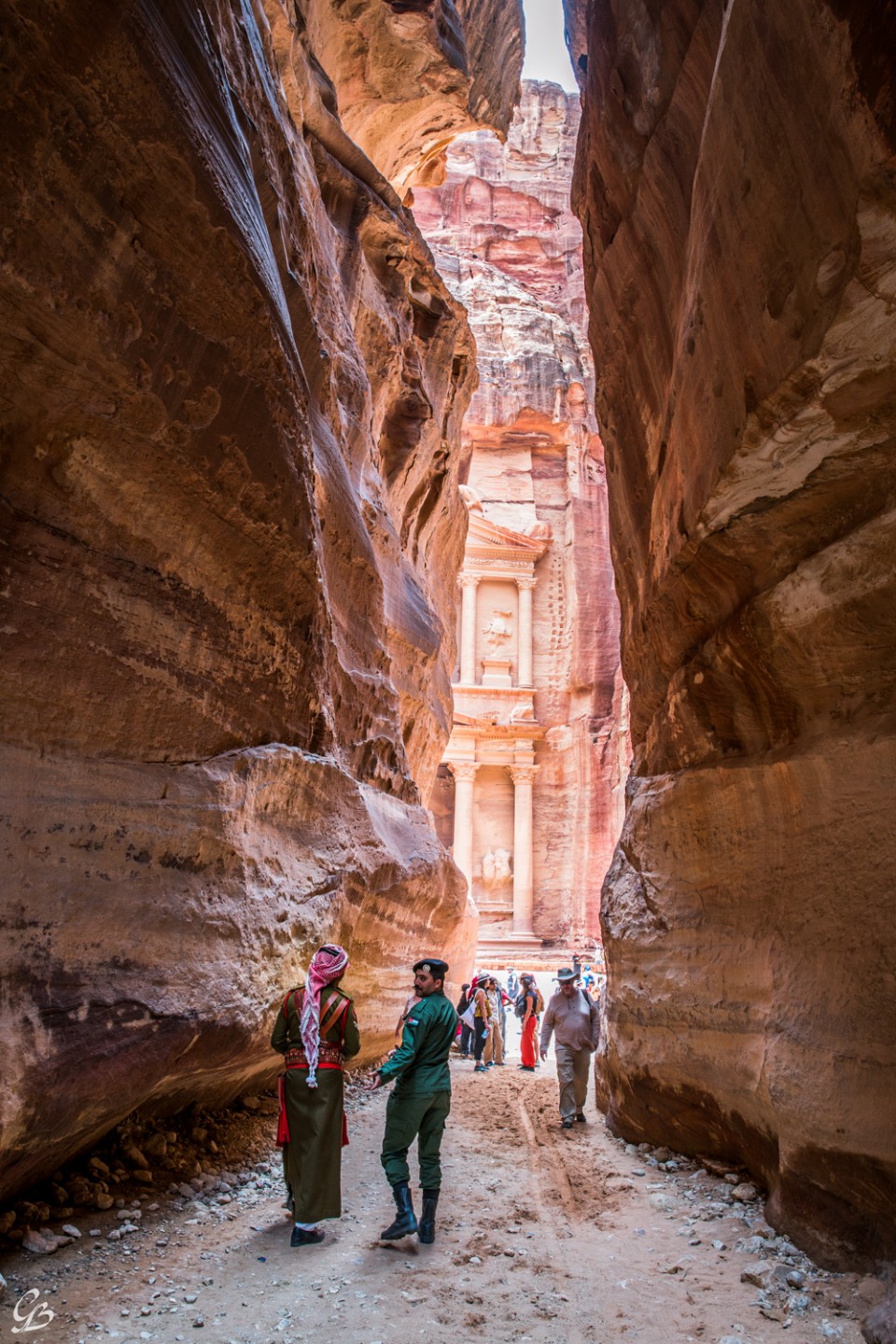
Although there are no gold and precious gemstones, but Al-Khazneh is still a real architectural treasure. Although I was prepared, when Siq lifted the final curtain and Al-Khazneh appeared in front of my eyes, I was still completely surprised and overwhelmed. Al-Khazneh was built around the 1st century BC, nearly 40 meters high. The entire massive building was carved straight into Petra’s signature rose-red sandstone, inside there are large rooms which also deep carved in the mountain, whose original purpose is still an unsolved secret. I stared blankly at the façade of the ancient Greek architecture, gentle, splendid, mysterious and elegant designed with perfect proportions. Every detail is put in its right place, sophisticated but not cumbersome. That much is enough to fascinate visitors, but the sunrise also pours more color on the stone surface, making them so beautiful and magical in pink. It was amazing, and that’s how I fell in love with Petra.
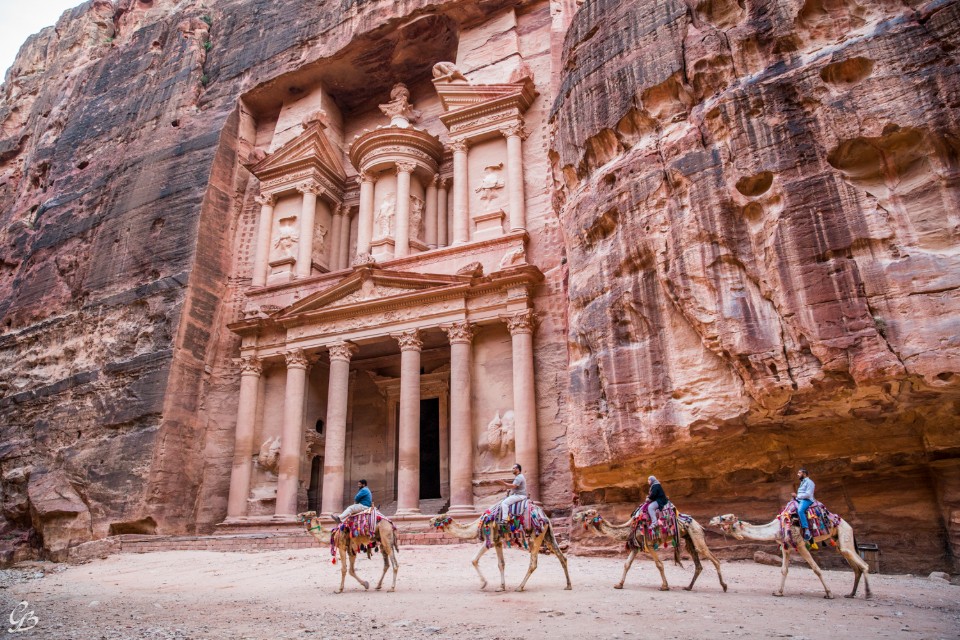
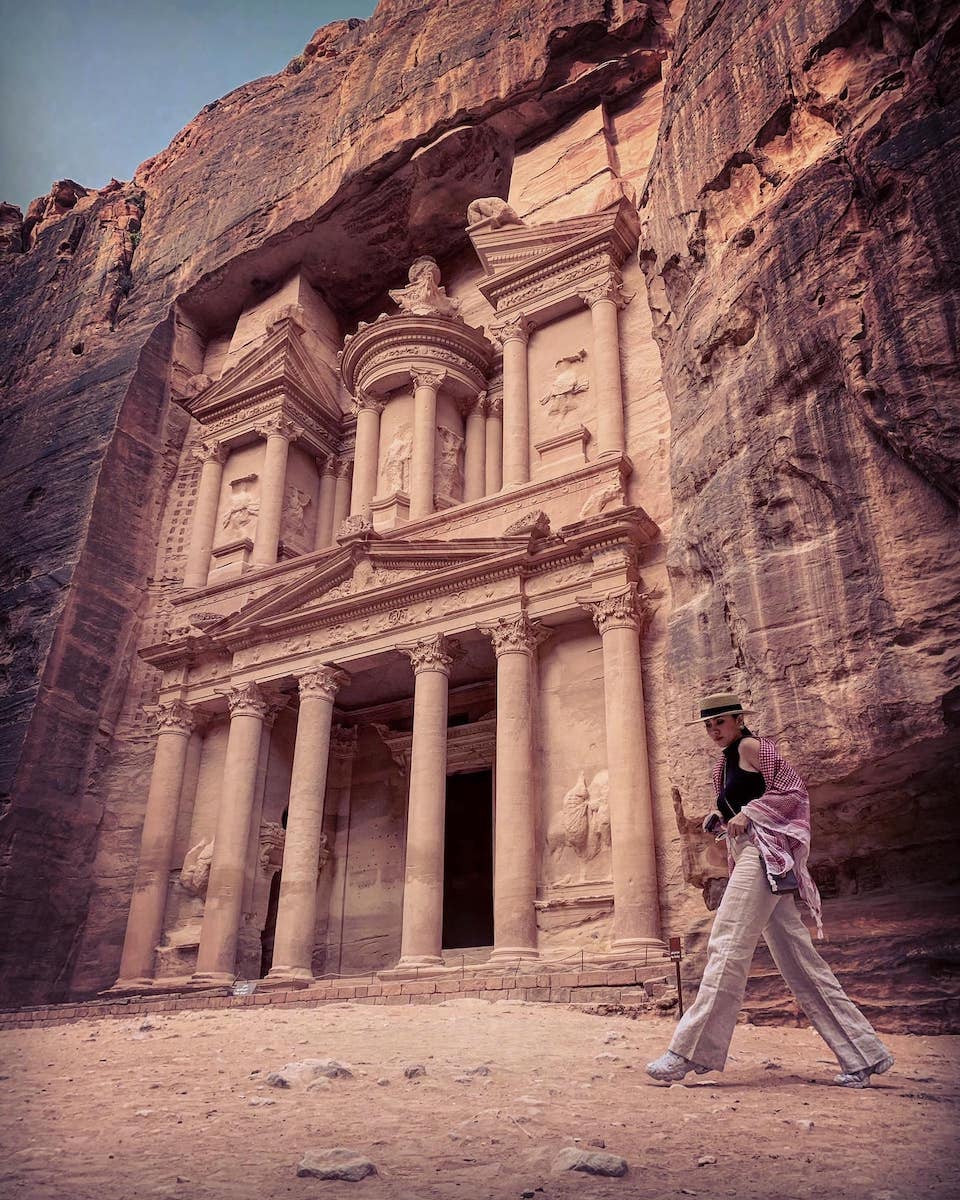
Petra Jordan travel guide: Going deep into the heart of the city

If tourists traveling in groups to Petra for a day will only stop in front of Al-Khazneh, then I follow the wanderers to continue going to deep into the city center. The center of Petra is spread out along a wide boulevard paved with large Roman slates. From here, large architectural works are planned according to the structure of the mountain gorges deeply rooted in the natural valleys, running to all directions. With their talents, the architects of Egypt, Greece, Rome, and even the Nabatean, together contributed to building a magnificent Petra, a part of which has survived to this day.
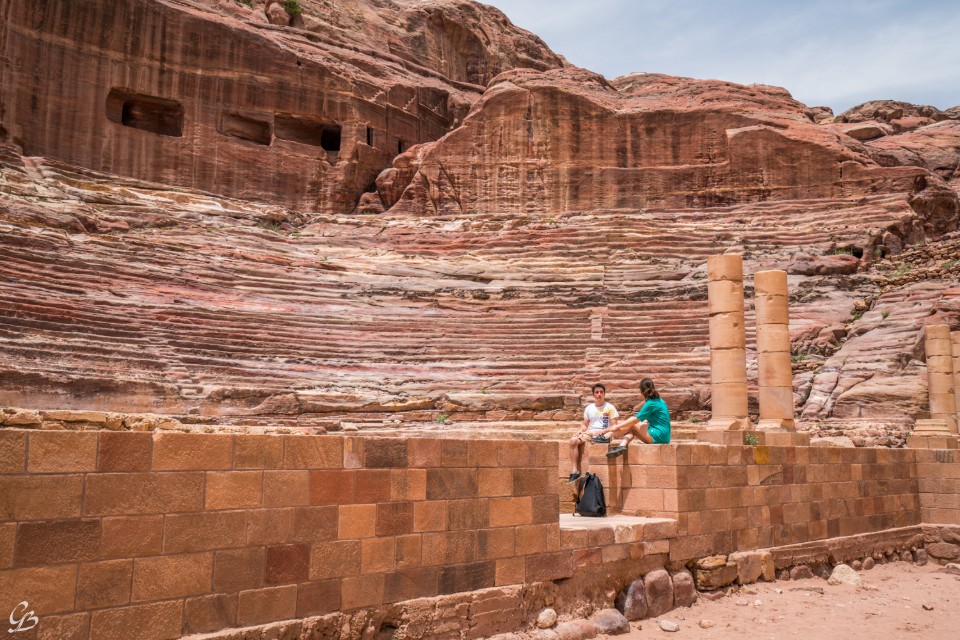
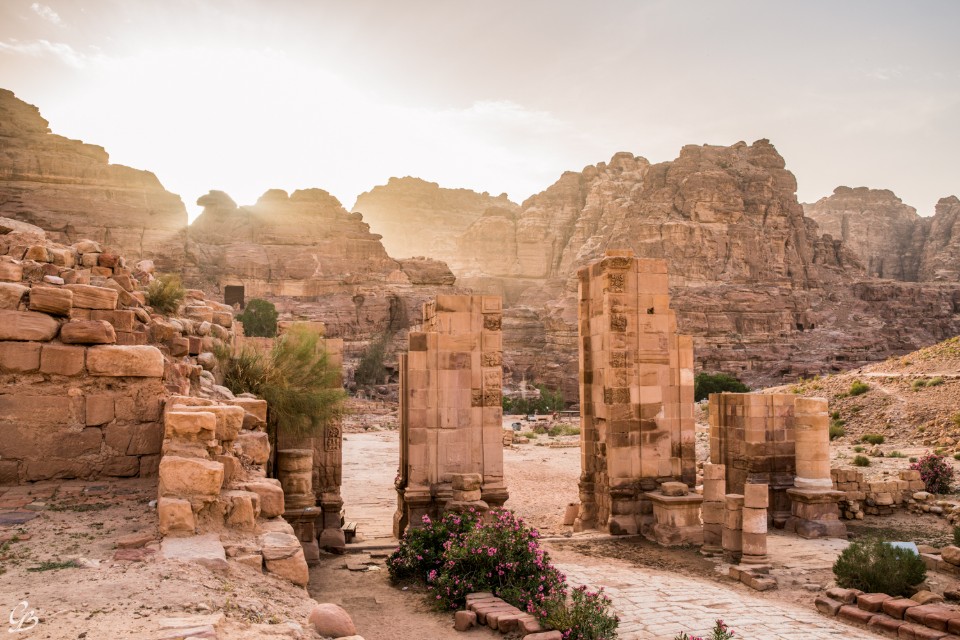
For decades, people mistook Petra for the city of spirits because of the large scale of the temples and tombs. Like many other ancient peoples, the Nabateans took the eternal world very seriously. They believe in two types of souls: The rouah – “breath”, spiritual, which will return to the fairyland after death, and nefesh – The soul carrying the personality of the deceased, continue exist in the tomb. Therefore, the massive burial structures carved onto the surface of most of the high cliffs surrounding the city make we think of Petra as a giant cemetery. However, Petra was once a “thriving city”. Just the tents, warehouses, shops, camel caravans and remnants of the Nabatean nomadic way of life that have been forgotten after centuries of oblivion.

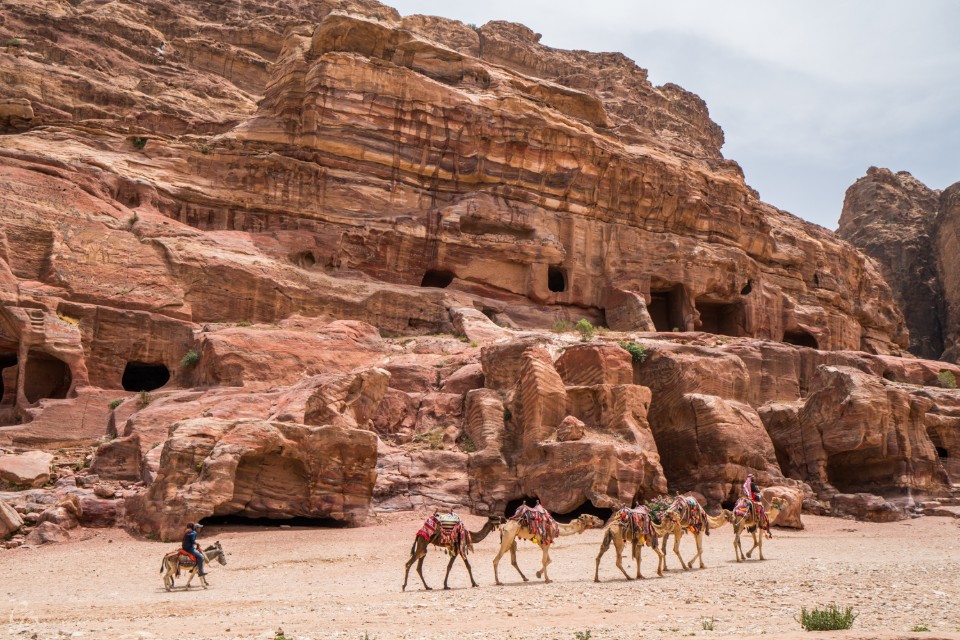
Leaving the main road, escaping the clamor of Bedouin souvenir stalls, I wandered through countless trails to the furthest points in the city. Trails, mostly carved into steps along the mountainside, took me higher and higher, to points that encompassed all the valleys that make up Petra. May is still late spring in Jordan. The pink oleander trees along the stream banks were drying up, preparing for a hot summer.
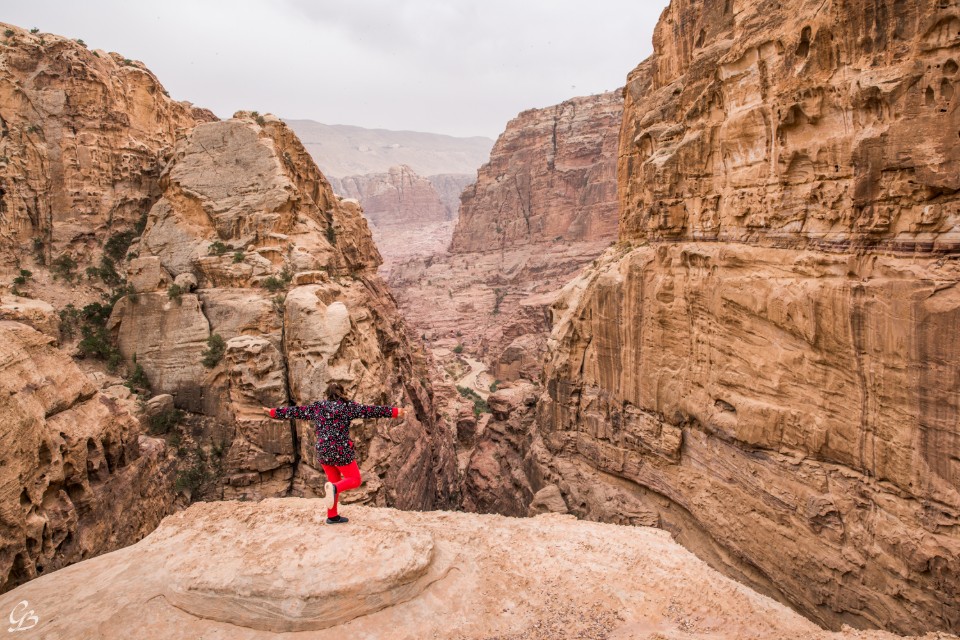
For patient guests, at the end of an endless series of stone stairs is Monastery, which in Arabic is Ad-Deir, means “monastery” will meet you at the other end of the city. Ad-Deir was built around the 2nd century AD. This is also a mausoleum, similar in architecture to Al-Khazneh, but carved with more square proportions, creating a sense of solidity, strong and majesty.
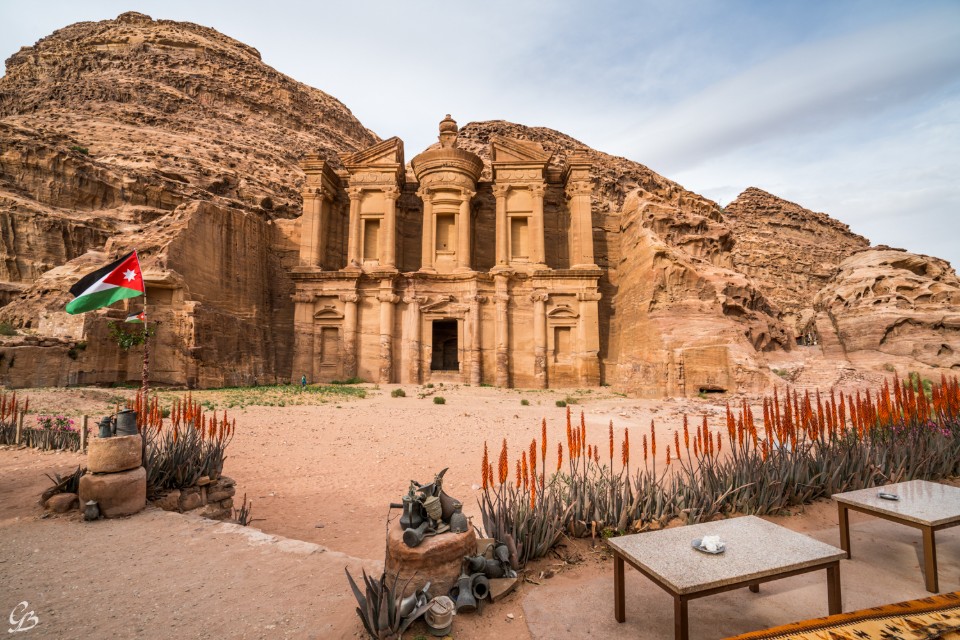
Exploring Petra is about discovering the unexpected after every bend. Petra not only has architectural works of thousands of years, but also a harmony between a culture that once developed to its peak and majestic nature. I went from one surprise to another. Sometimes, admiring the beauty of a pink cliff with iridescent veins, right behind it is a quiet Greek temple, with a harmonious structure and preserved almost intact. My mind immediately left the eerie veins of the rock to get lost into an ancient, breathtakingly mysterious world. Another time, while standing on a cliff, watching the afternoon light shine like honey on the facades of the “royal” mausoleums, I was attracted by a herd of camels running past, throwing dust over the road below. The scene suddenly tinged with a sandy color like in an old movie full of nostalgia. My heart feels like someone was squeezing. So beautiful. I was living a dream!
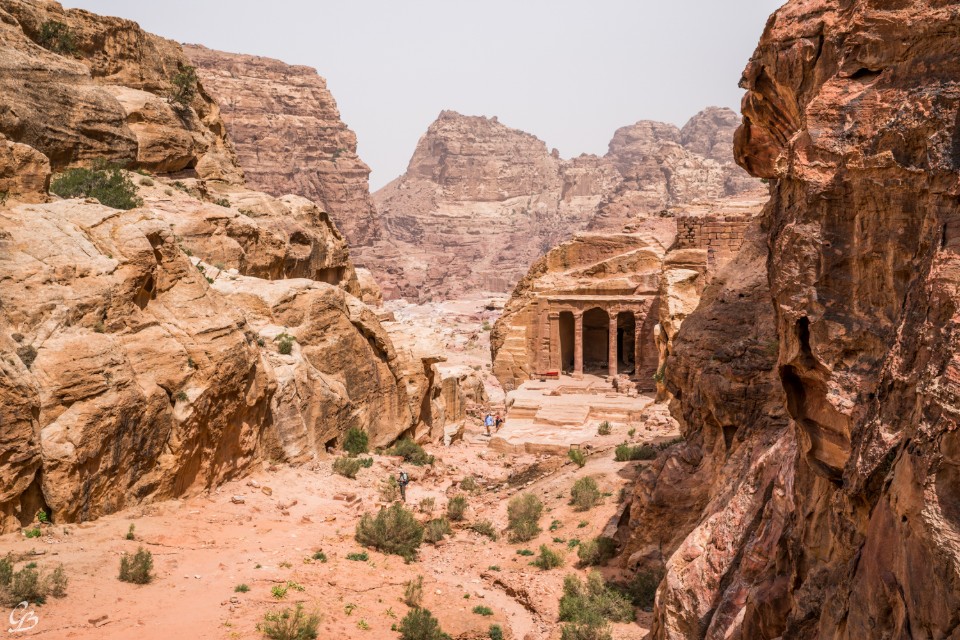
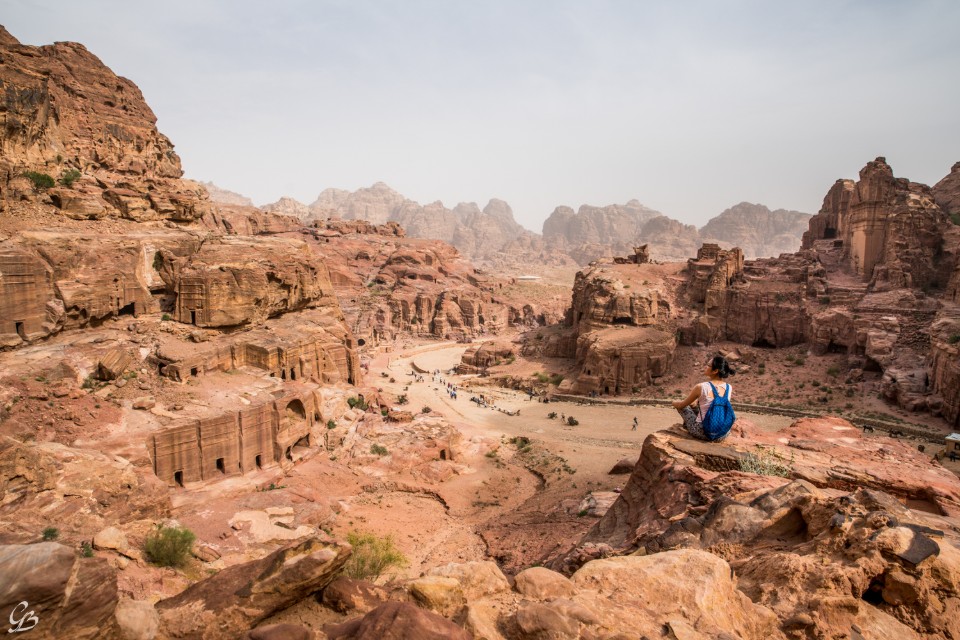
Jordan travel guide and suggested itinerary
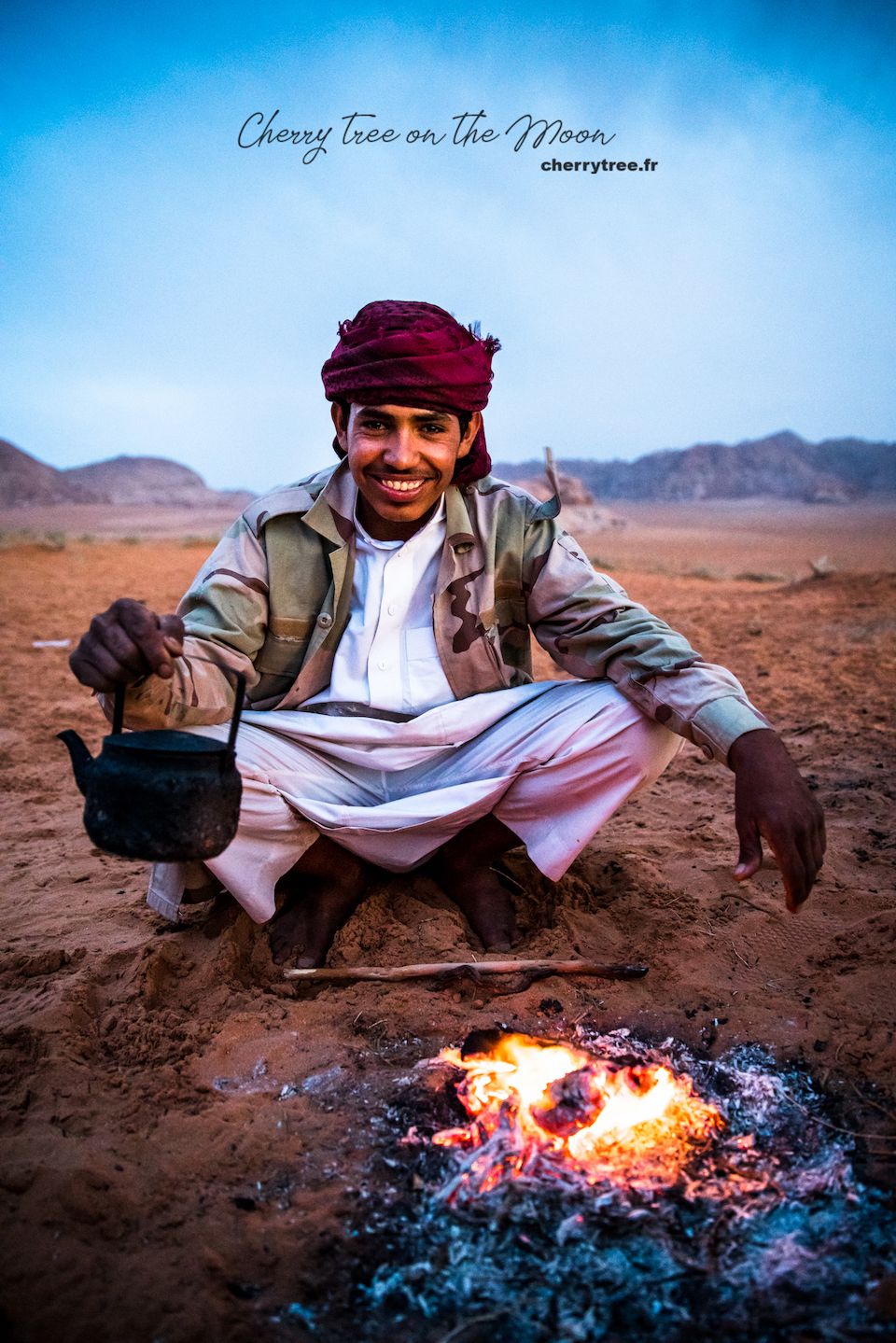
A detailed article on Jordan travel guide as well as suggested some itineraries for 5, 7, 10 days and other useful Jordan travel tips you can find here: Jordan travel blog — The fullest Jordan travel guide & suggested Jordan itinerary for first-timers.
Jordanian Currency
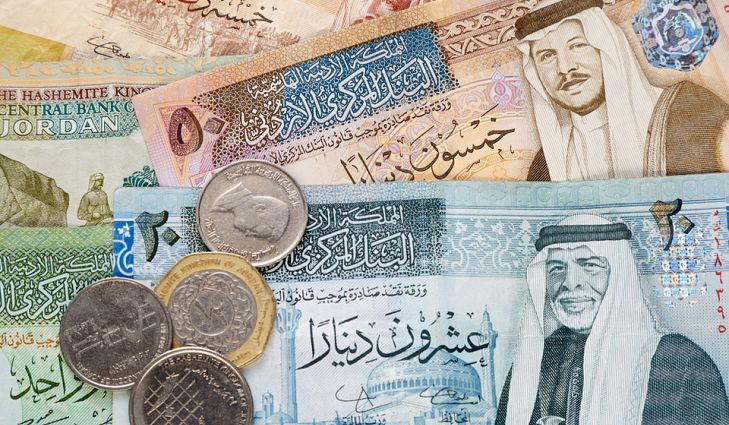
I have included the exchange rates, so you can get an idea of the prices of services in Jordan. Going to Jordan on your own is not as expensive as going on a tour.
Jordan uses Jordanian Dinar (JOD) currency, which has a fixed rate to the USD. This is one of the strongest currency in the world. 1 USD is only equivalent 0.71 JOD.
1 JOD = 1,41 USD = 1.29 € (exchange rate at the early of March 2022).
Petra Jordan travel guide: How to get to Petra?
How to get to Petra from Amman?

Bus: 11 JOD/person (2022 price). It takes 3.5 hours from Amman to Petra for a distance of about 250km. Example bus of the JETT bus.
Taxi: 80 JOD / 1 car. You can bargain with taxi driver.
How to get to Petra from Dana?
Petra was one of the destinations of my more than 10 days trip in Jordan. I came here from the Dana Biosphere Reserve by rented a taxi at the guesthouse in Dana. Taxi price is 30 JOD / 1 car, the road is 55 km long, about 1 hour of traveling.
In addition, from Dana there are many other ways to get to Petra, for example, after 1 day trek in Dana, from the end of the trek route Wadi Dana, you can rent a car (pre-booked car from the hotel in Dana) to go straight to Petra instead of going back to spend another night in Dana. They will pick up at the end of the trek Wadi Dana to get to Petra with the cost of 40 JOD / 1 trip.
If you like to trek, you can hike on the trail from Dana to Petra, it takes about 3 days, the first day, you will trek the Wadi Dana trail. This is one of the most popular trekking route of this biosphere reserve. Days 2 and 3 continue to hiking in the direction of Petra through many beautiful and wild landscapes in the Jordan Desert, including Little Petra. This trek should be accompanied by a guide. All guesthouses in Dana provide a guide service.
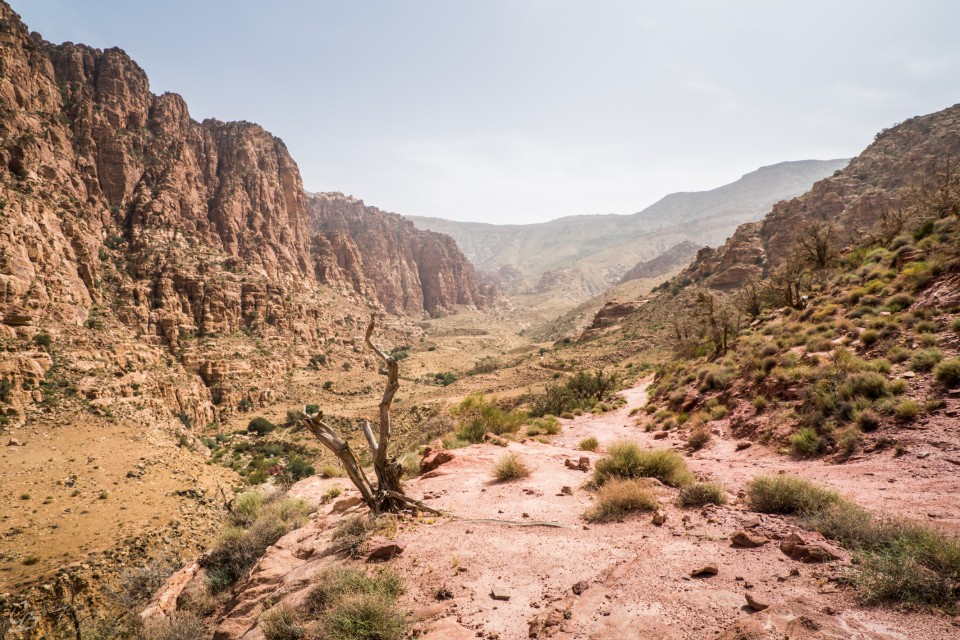
How to go to Petra from Aqaba?
- Taxi: 50 JOD / 1 trip.
- Minibus: About 10 JOD / 1 person. From Aqaba you can catch a minibus to Wadi Musa at the bus stop in the center, next to the Aqaba Police Station. The bus takes 1.5 to 2 hours with 5 trips a day, there is no bus every Friday because it is a Muslim holiday. The first bus runs at about 6 o’clock and the bus only runs when it is full of passengers. In fact, there is no specific bus schedule, the bus will run whenever it “likes”.
How to get around Petra and Wadi Musa?
Wadi Musa is a new neighborhood next to the ancient city of Petra. There are all hotel services, restaurants, shops here.
Taxis in the city:
- From Petra gate to Wadi Musa center, 2 km uphill: 3 JOD / 1 trip. Taxi in Petra usually offers 5 JOD and says it is the common price, but I went 4 times and all bargained for 3 JOD.
- From Wadi Musa center to Petra gate, 2 km downhill: 1 JOD / 1 trip. Taxi will run to the parking lot at Petra gate and often let you go with a very low price.
- From Petra to Little Petra: 7 JOD / 1 trip.
Petra travel guide: Getting around inside Petra

The ancient city of Petra is surrounded by rocky mountains, as a natural defensive wall protecting the city. Therefore, the entrance to Petra is also quite limited. There are two entrances to Petra: The main gate (visitor center) on the east side, which leads to the new city of Wadi Musa, and a side gate on the north side leading to the Bedouin village. Tourists usually access Petra by the main gate.
From the main gate to the center of Petra is about 4 km (see details on the map of trekking routes below). This route is divided into 3 sections:
- From the main gate to the old dam, at the beginning of Siq road: 1 km. The white stone paved road had no shade at all. In the hot season, the sun will dazzle your eyes. Visitors often walk, ride horses or take horse-drawn carriages. The entrance ticket to Petra includes 1 ride on horseback, but you will have to pay an additional tip according to the agreement. The horse-drawn carriage service is quite expensive (20, 40 JOD), the price is listed on the wall outside the main gate.
- Siq Canyon: 1.2 km. This is the natural entrance of the ancient Nabateans, connecting the dam to one of Petra’s most prominent structures, the Treasury or Al-Khazneh. This section of the canyon is very narrow, always in the shade of high cliffs running on both sides. So, walking here is not very tiring. If you have rented a horse carriage from the main gate, it will take you here and stop in front of Al-Khazneh. Inside Petra, all vehicles are prohibited.
- From Al-Khazneh to the center of Petra (Petra village): More than 1.5 km. This stretch of road passes many beautiful ruins of Petra. You can walk, rent a camel or ride a donkey. The price for a camel and donkey ride depends on the length of the distance and your bargaining ability.
Petra has many beautiful treks that lead you to visit ancient ruins. I will guide you more about the treks below. Most of the treks are accessible by donkey. If you are not able to climb or walk a lot, you can try this way.
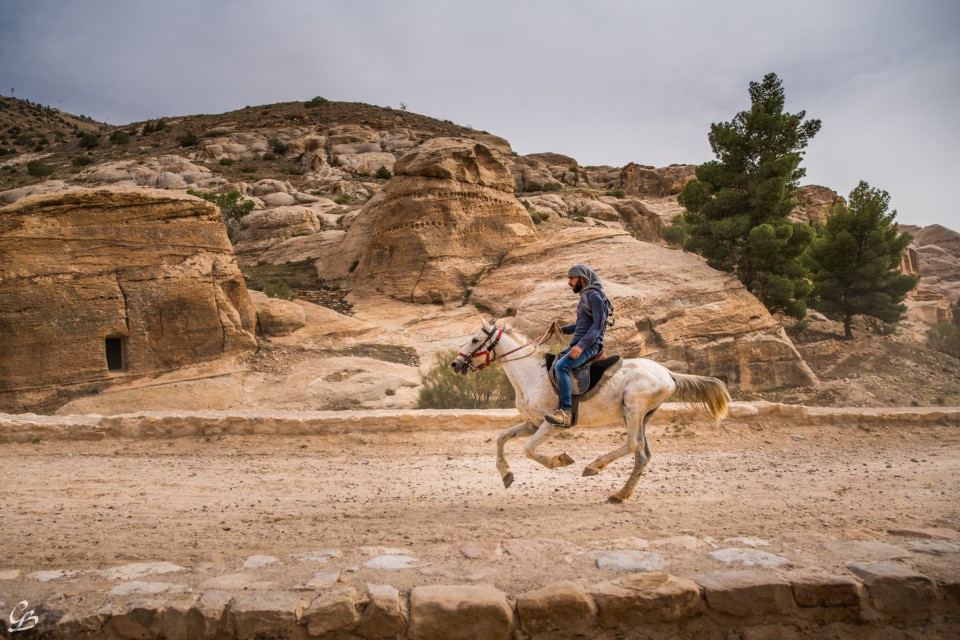
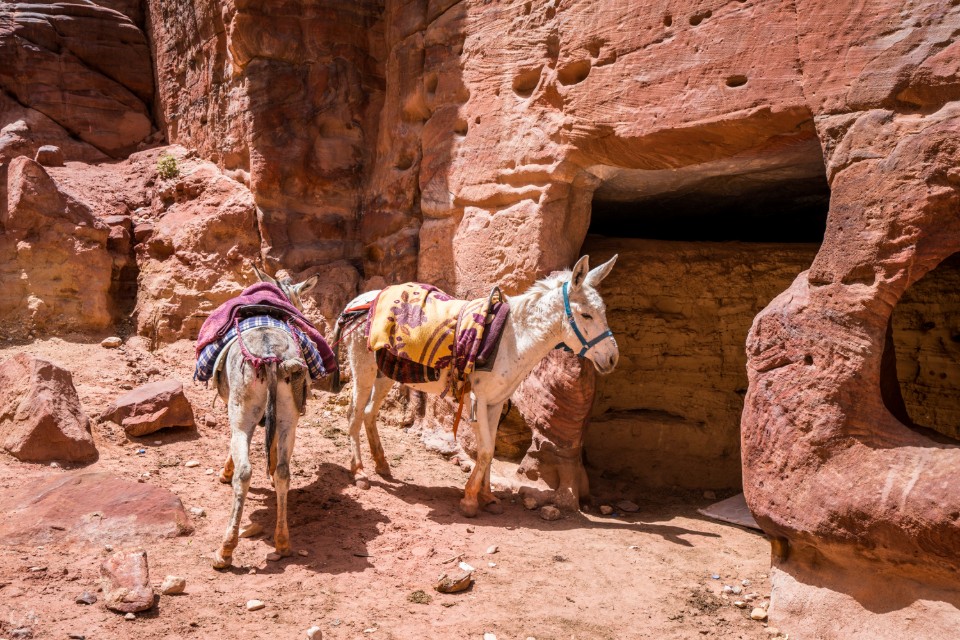
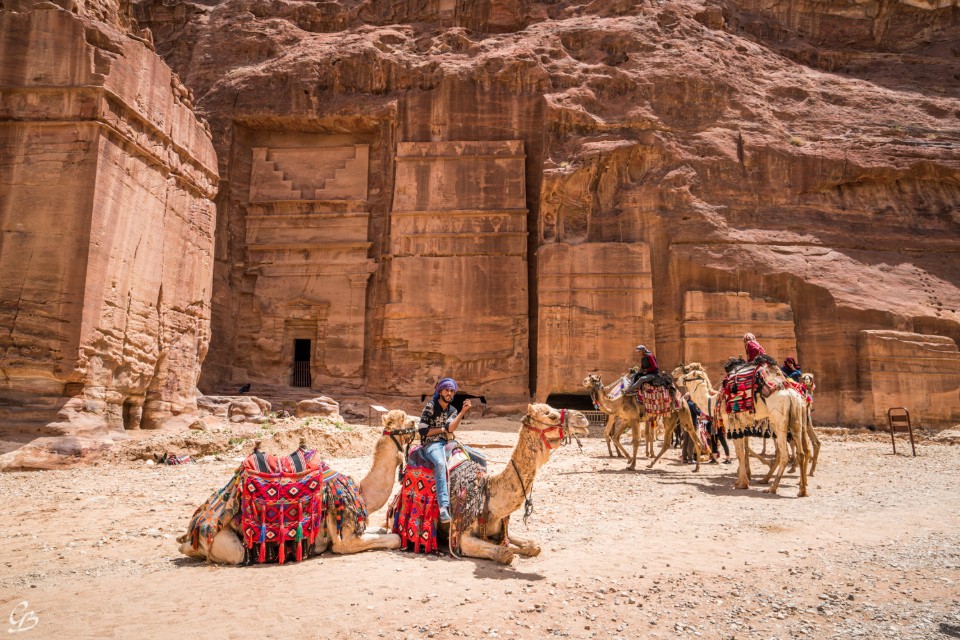
From Petra to Wadi Rum Desert
- Taxi: 40 JOD / 1 trip. You should book a taxi the day before and tell them to come to the hotel to pick you up early in the morning, so that you can go to the Wadi Rum desert and take the desert tour on time. Hotels can also hail a car for you, but it’s usually more expensive from 5 to 10 JOD.
- Minibus: 10 JOD / 1 person. From Petra to Wadi Rum runs at around 6am. Ask the receptionist to book a bus from the day before, then at 6 am you go to the hotel door to wait. The bus will go through all the hotels that have booked the car to pick up their guests.
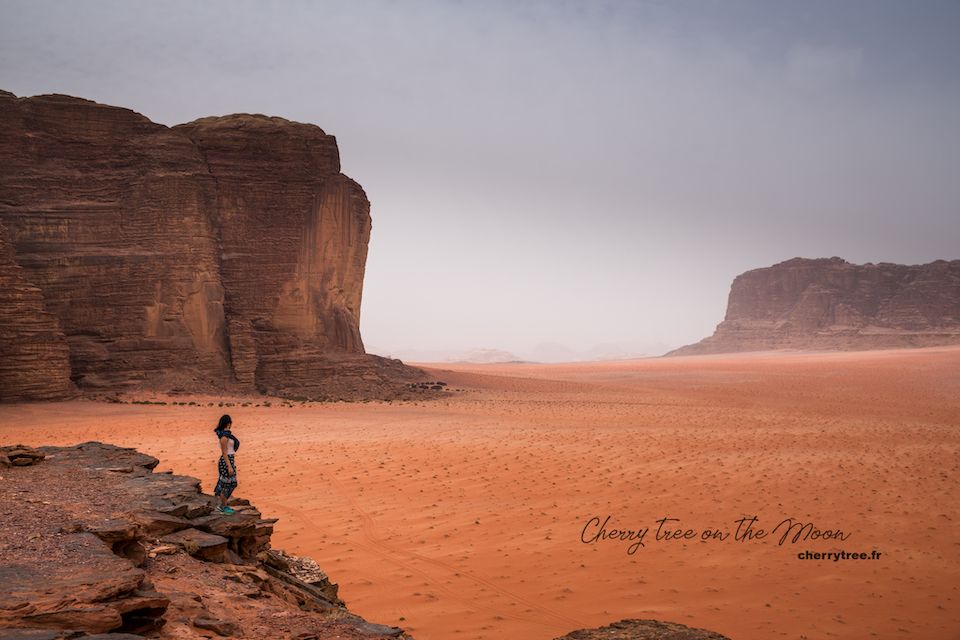
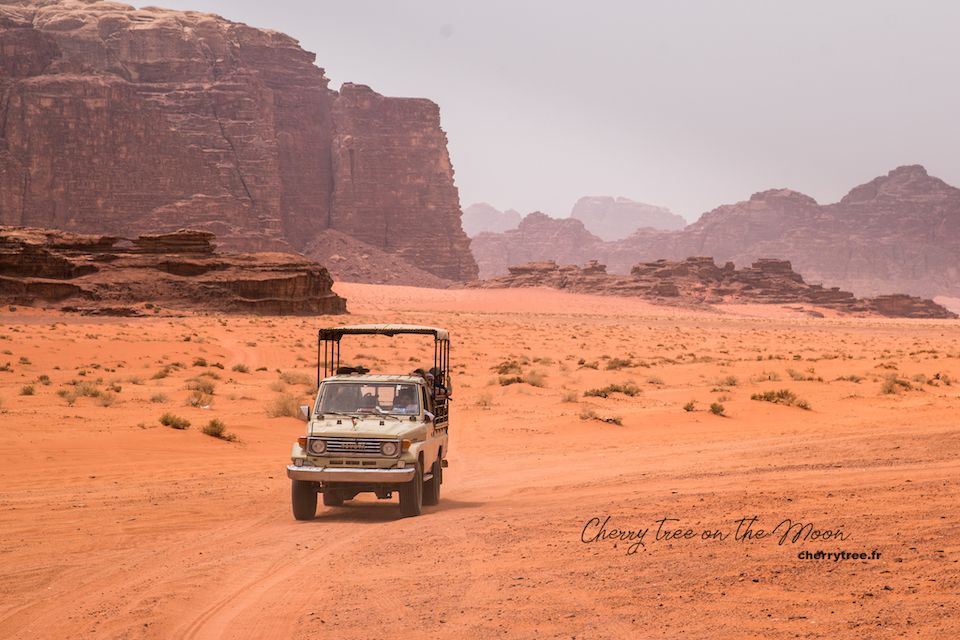
Petra guide: Petra tickets
Entrance ticket
There are 3 types of tickets to visit Petra for tourists who staying in Jordan for at least 1 night:
- 1 day: 50 JOD
- 2 days: 55 JOD
- 3 days: 60 JOD
- Free from the 4th day onwards
Tickets for guests who do not spend a night in Jordan here.
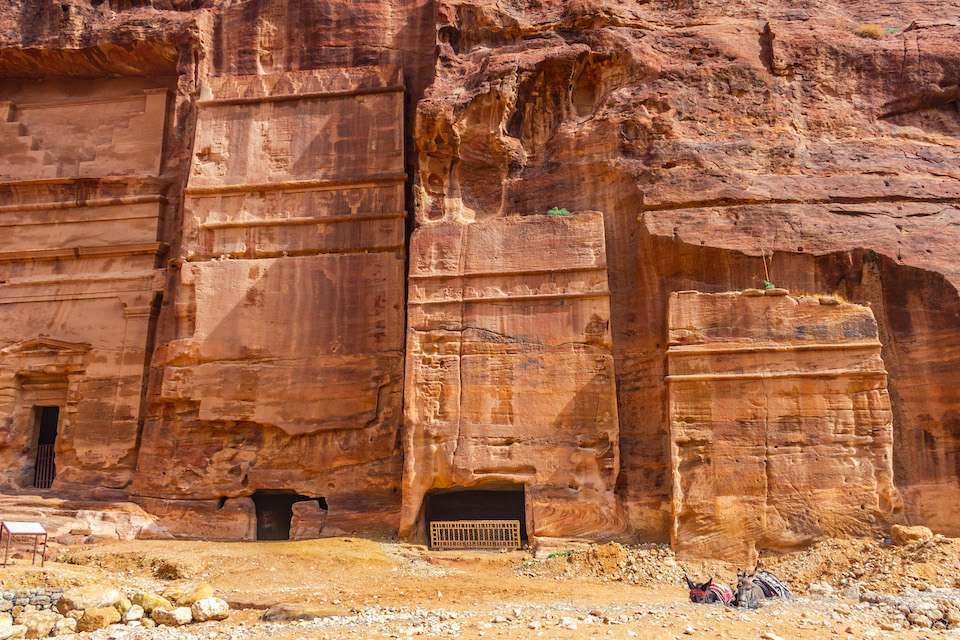
If you intend to go to Petra, you should buy the Jordan Pass. This is a prepaid ticket that gives you visa-fee and access to more than 40 tourist attractions across Jordan, including Petra. Jordan Pass costs 70, 75 and 80 JOD, equivalent to 3 types of tickets to Petra above.
Jordan pass must be purchased before paying the visa fee. Buy online at the following link: Jordan Pass.
Petra by Night
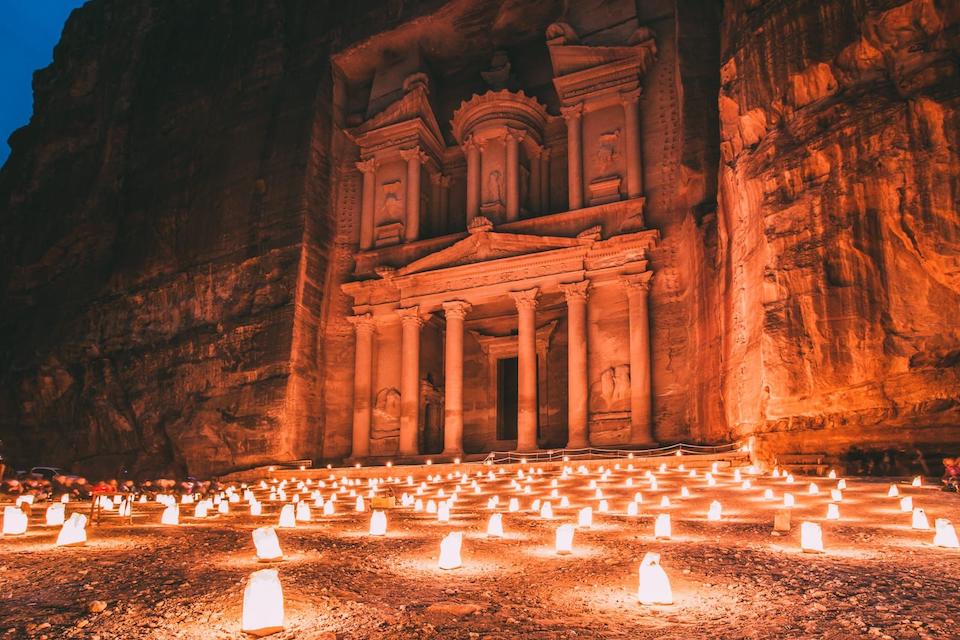
Petra is also open in the evening to tourists on Mondays, Wednesdays and Thursdays. On these times, you can visit a candlelit Siq road and Treasury. Petra by Night ticket is not included in the daytime fare. You have to pay an extra 17 JOD at the ticket counter at the main gate.
More information about Petra by Night here.
Other Services
Prices for guide and horse-drawn carriage services are available here.

Petra blog: Where to eat?
The center of Petra is quite isolated from the new city of Wadi Musa (4 km / 1 way). After stepping through the main gate of Petra, visitors have to walk or rent donkeys, camels, and horse-drawn carriages at expensive prices. So, you need to determine in advance where to have lunch to save the most distance and time as well. I have tried 3 different ways:
- Arriving in Petra in the morning, go to Wadi Musa for lunch at noon, then return to Petra after eating. This is the best way to eat because the food in Wadi Musa is super savory. But walking outside is quite tiring. The distance of both going and returning is 8 km just to have lunch made me falter, find another way for the following days.
- Lunch at the restaurant inside Petra. In Petra there are many eateries for tourists, suitable to have a full meal. The restaurant is located near the center, with tables and chairs, shade and wifi. Some shops even have air conditioning. However, food in Petra is about 3, 4 times more expensive than outside, depending on the location.
- Bring picnic items from outside. After three days wandering in Petra, this is the way I like best. Hotels all have picnic preparation services including bread, 1 box of canned fish, fresh fruit and 1 bottle of juice, for about 5 to 7 JOD. If you want to be even cheaper, you can buy food in supermarkets or convenience stores in Wadi Musa and bring them with you. Imagine having lunch while reclining in a certain Bedouin hut on the viewpoints, ordering an extra cup of tea, eyes looking at the vast desert, below are two thousand years old ruins. I’m only just to say a “miracle”.
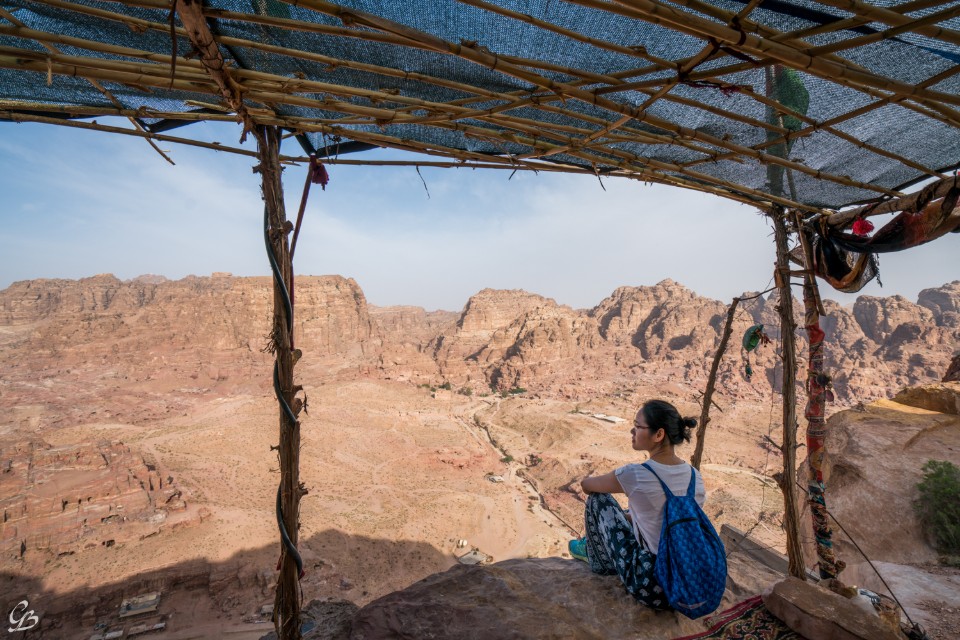
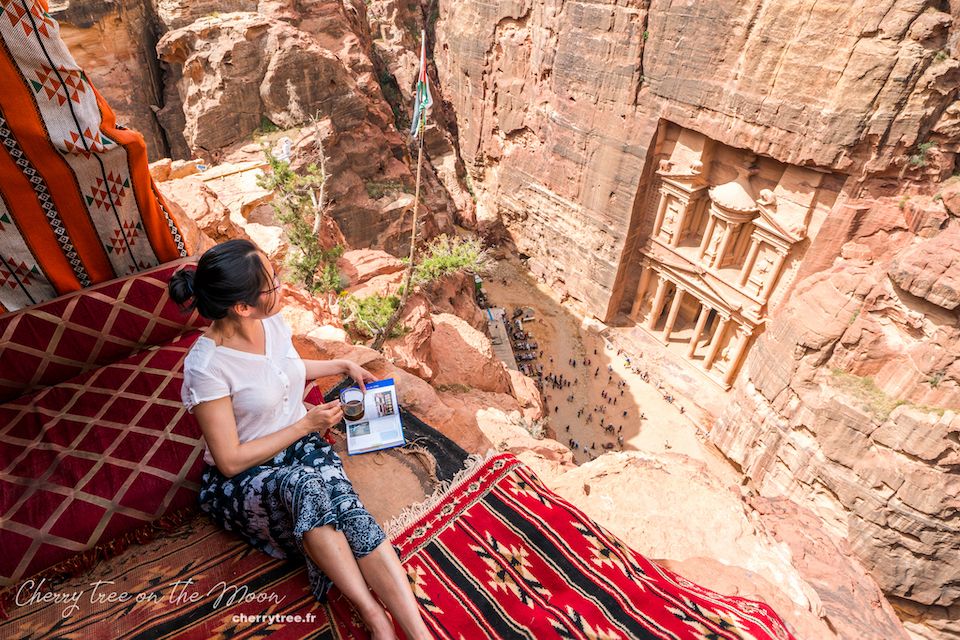
In the ancient town of Petra
Crown Plaza Basin has the best food in the center of Petra, the shop has air conditioning and wifi. Buffet meal price: 27 JOD / 1 person.
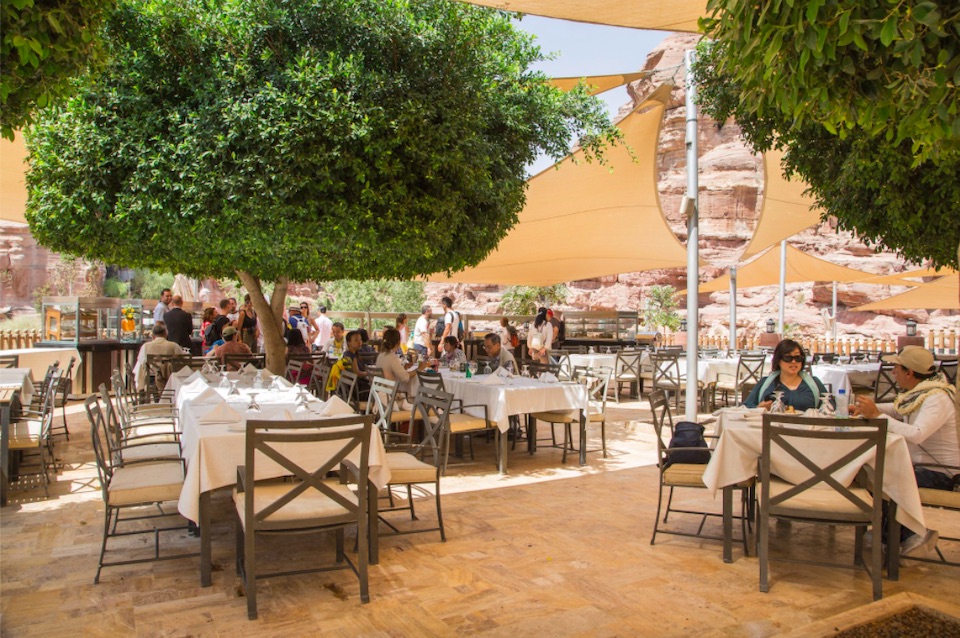
In the Wadi Musa center
Although Petra is very attractive to tourists in groups, Wadi Musa has many small, lovely restaurants for solo travelers. Most of these shops sell traditional Jordanian dishes, suitable for Southeast Asian taste and much cheaper than inside Petra.
Three delicious eateries in Wadi Musa, ranked in order of liking from top to bottom:
- Al-Wadi Restaurant, located in the heart of Wadi Musa. This is really the best restaurant in Petra and also my favorite restaurant during my trip to Jordan. This shop was recommended by both the driver who took me from Amman and my hotel staff. However, the shop is not too crowded, the service is very good and especially the bread here is made on the spot, delicious, soft and hot. Affordable price: 15 – 16 JOD/2 adults.
- Beit Al-Barakah Restaurant, right across from Al-Wadi, in the heart of Wadi Musa. Food and drink are also delicious and super cheap. Dinner, including drinks: 17 JOD / 2 adults.
- My Mom’s Recipe Restaurant, just 200 meters from the main gate of Petra towards the center of Wadi Musa. The restaurant has a very nice Arabic-style rooftop decoration, the food is quite good. Dinner: 17 – 20 JOD / 2 adults.
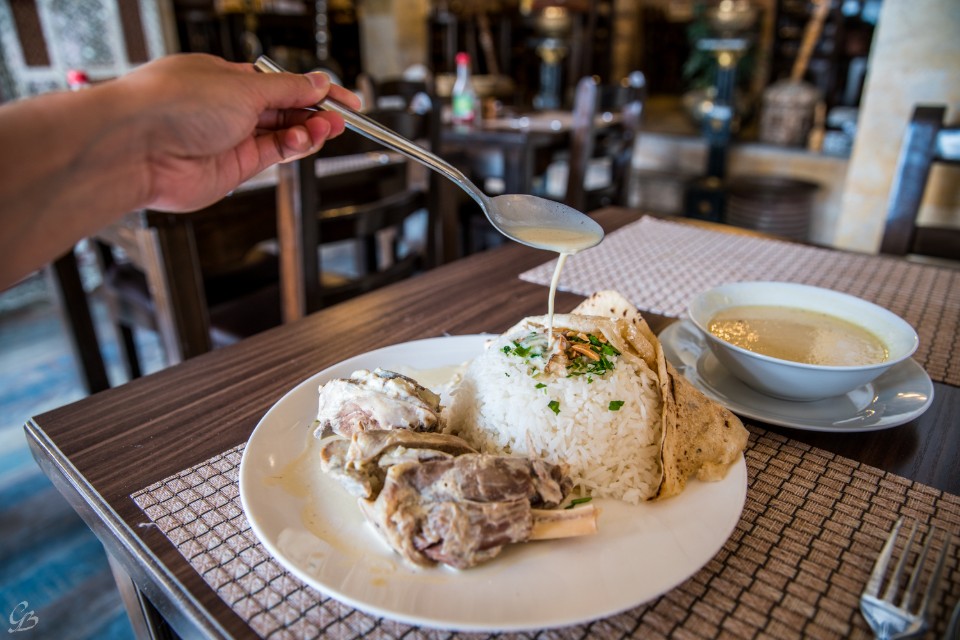
Petra tourist guide: Where to stay?
Jordan is a tourist country which attract millions of visitors every year, so there is no shortage of accommodations, from budget hostels, guesthouses to upscale, luxury 5-stars hotels. During the peak season, you should book early, months to weeks in advance, to get good rooms and cheap prices.
There are two main places to stay around Petra, about 2 km apart:
Option 1: The place near the main entrance to Petra. With an advantage is convenient to get to Petra. Cons is a bit far from good eateries in the center of Wadi Musa. For example, a nice hotel with a good price in this area:
- La Maison (Agoda.com or Booking.com)
- Petra Guesthouse (Agoda.com or Booking.com) is right at the main entrance to Petra, next to the visitor center.
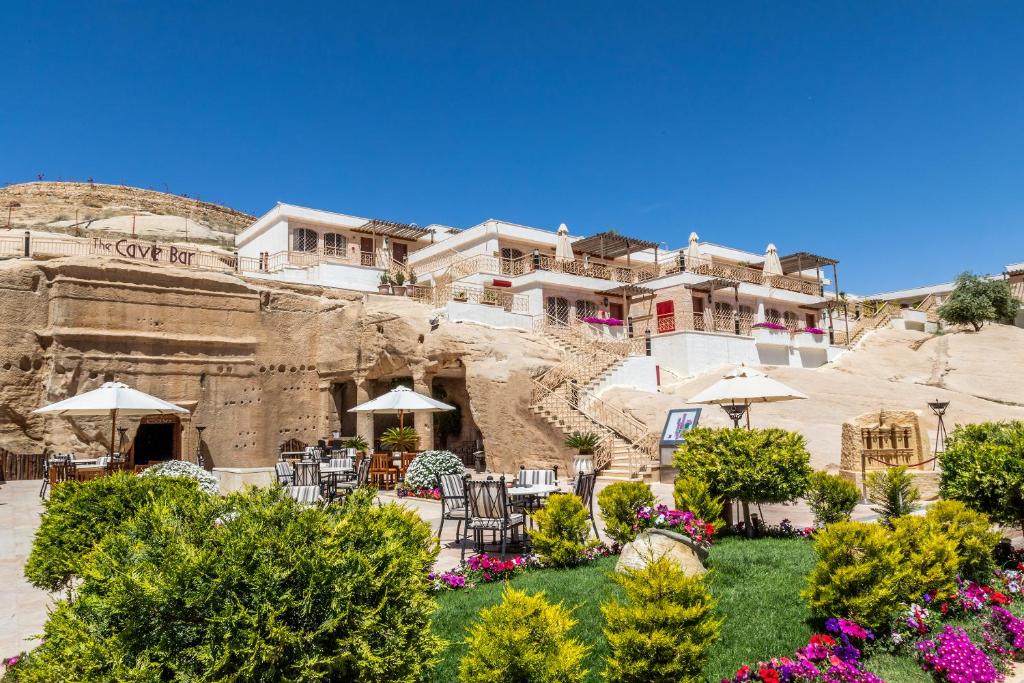
Option 2: In the center of Wadi Musa. In the evening, it is easy to go out to eat and buy things in the supermarket. Cons is a bit far from Petra. There is no taxi in the early morning, so you have to walk for about 20 minutes to half an hour. Example: Seven Wonders Hotel (Agoda.com or Booking.com).
I stayed at Seven Wonders along with a couple of friends I made at La Maison. We all booked rooms on Booking.com.
Below we recommend more best budget, mid-range and upscale hotels with good ratings and reviews you can refer to.
- Movenpick Resort Petra (Agoda.com or Booking.com).
- Petra Sella Hotel (Agoda.com or Booking.com).
- Petra Moon Hotel (Agoda.com or Booking.com).
- Petra Marriott Hotel (Agoda.com or Booking.com).
- Amra Palace International Hotel (Agoda.com or Booking.com).
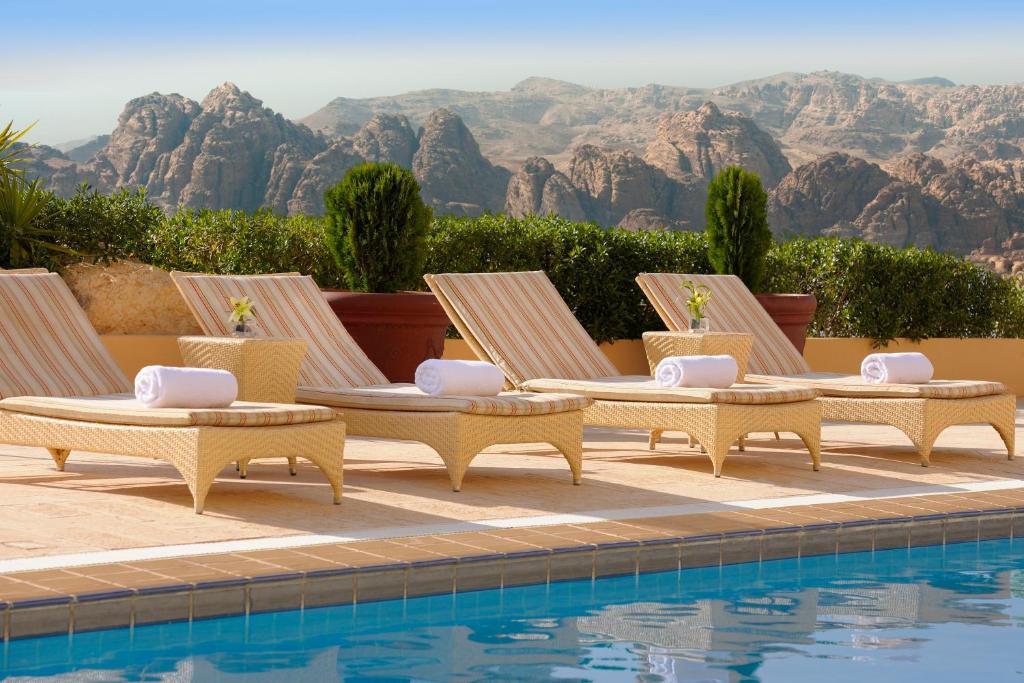
Check out more top hotels in Petra and Wadi Musa via Agoda.com or Booking.com.
What to do in Petra: Hiking trails in Petra
Having been to Petra and having enough health for a long hike, it would be a pity if you did not take at least one trek in Petra. These treks take you to beautiful and deserted areas, not being disturbed by tourists in groups. There are 8 main trekking trails (pictured below), in which I like the best route number 2 – Al-Khubtha Trail and number 3 – High Place of Sacrifice Trail.
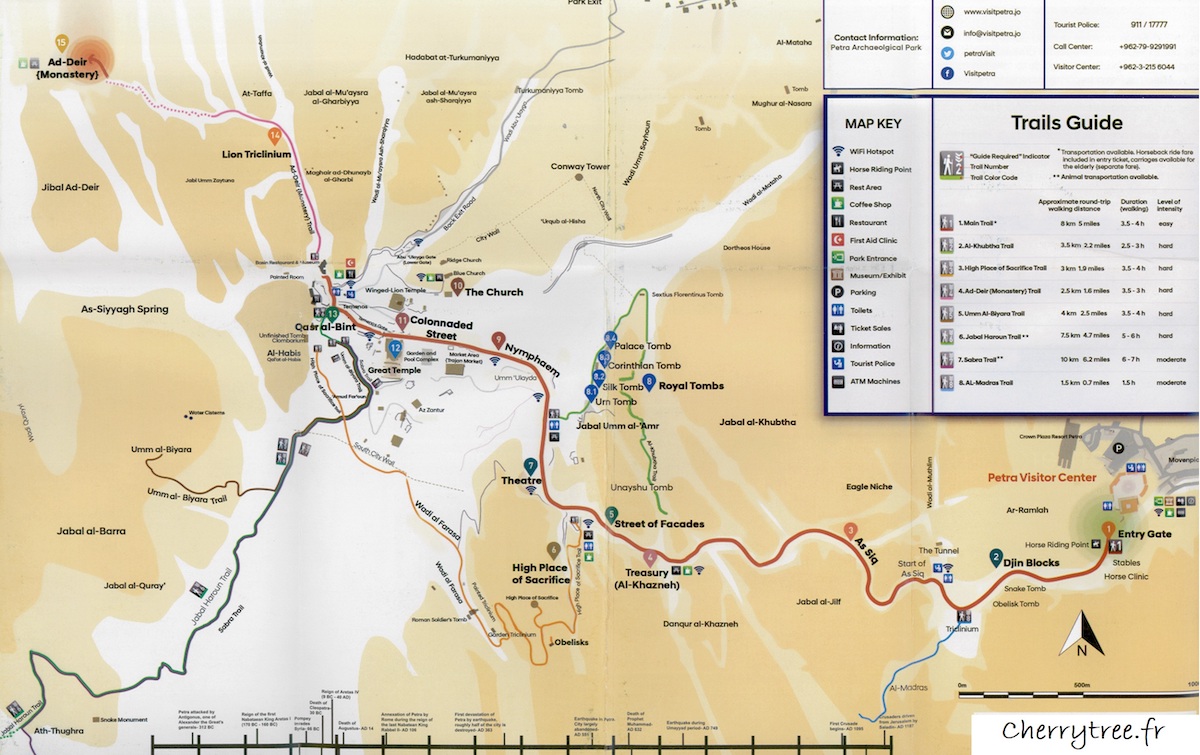
Al-Khubtha Trail, recommended to hike in morning. This trail is only 3.5 km long both going and returning. Although it is short, there is a bit steep in the middle section when you have to climb the stone stairs. Be patient and keep hiking because the end of this trail is a real reward. You will come to a Bedouin hut and tea house. Below is a panoramic view of the magnificent the Treasury (Al-Khazneh) when seen from above. Sitting here drinking tea, watching the sun caress the sandstone façade of Petra’s treasure, there is nothing more wonderful.

High Place of Sacrifice Trail, recommended to hike in early morning. The 3-km (1-way) trail leads from an alley on the Street of Facades into central Petra following a detour through the highest points. At the beginning of the trail, when you start hiking up, you will see the Street of Facades right below. The scene is like something straight out of a movie. Then you will ascend to the High Place of Sacrifice, where the Nabateans performed their sacrifices. This trail also takes us through many “secret” valleys, poetic temples and tombs nestled in the mountainside.

There is another trek that is very popular but a bit crowded, the trail 4 – Ad-Deir Trail, so hiking in the late afternoon will be less crowded. The trail is 2.5 km long both back and forth, leading from the center of Petra to one of Petra’s largest and most intact ruins, the Monastery (Ad-Deir). Hiking in the afternoon, you will be more comfortable because the trail is in the shade. The afternoon sunlight that covers the Ad-Deir is also more beautiful than the direction of the morning sun. Note that you need to watch time to leave Petra before dark.
You can see more of Petra’s other trails here.
Petra blog: The Beautiful View-Points Of Al-Khazneh
Surely anyone who sees Petra pictures online is also attracted by the extremely photogenic views of the Treasury (Al-Khazneh) from above. And not just in pictures. I came and saw it with my own eyes. The image of Petra’s “treasury” seen from these points is really stunning, overwhelming.
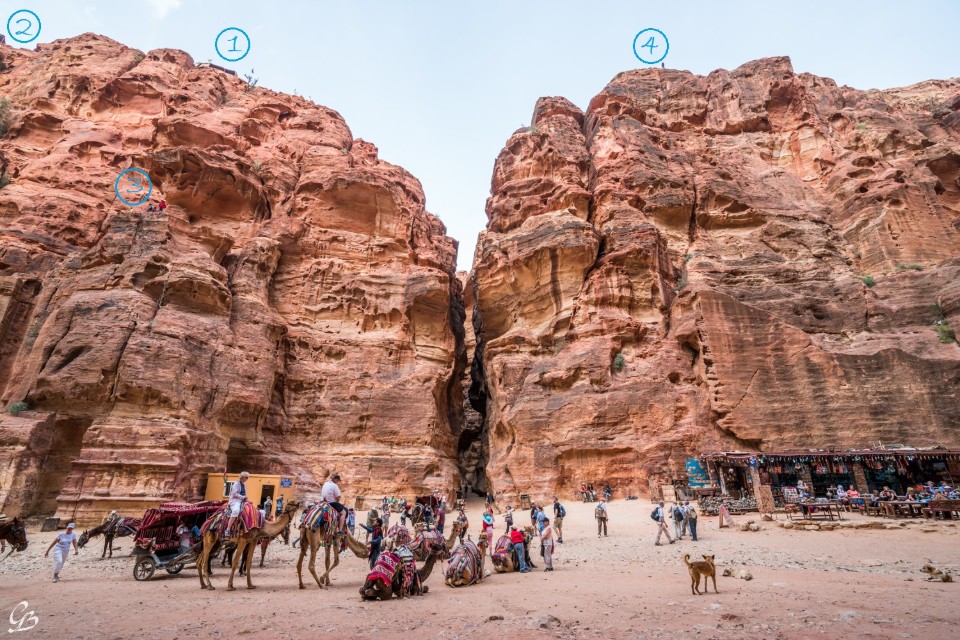
4 viewpoints looking down the Treasury. Photo taken with my back to the Treasury, looking at Siq Canyon.
1. At the end of Al-Khubtha Trail as I mentioned above. It takes about 1.5 hours to climb here. This end point is a nomadic teahouse, with eye-catching carpeting. This is probably the tea shop with the most beautiful view in the world that I have ever been to.
2. Also on Al-Khubtha Trail, a little in front of the tea house, there is a rock that protrudes out. From here, looking down at the Treasury is also very clear.
3. This viewpoint looks at Treasury level. Standing facing Siq, you will see a path up between the large rocks on the left hand side. The climb takes about 5, 10 minutes.
4. This viewpoint is similar to viewpoint 1, but can be climbed directly from the Treasury. When standing facing Siq, you will see a path up on the right hand side. The climb takes about 20, 30 minutes. However, this viewpoint is “made money” a lot by the Bedouins. They write the sign themselves, if you want to go up, you must have a local guide… But it’s not like that, in fact. Anyone who wants to go up, they also can do. However, if you have already reached viewpoint 1, you do not need to come here anymore because the view is the same as from viewpoint 1, but there is no tea shop, so it is not as photogenic.
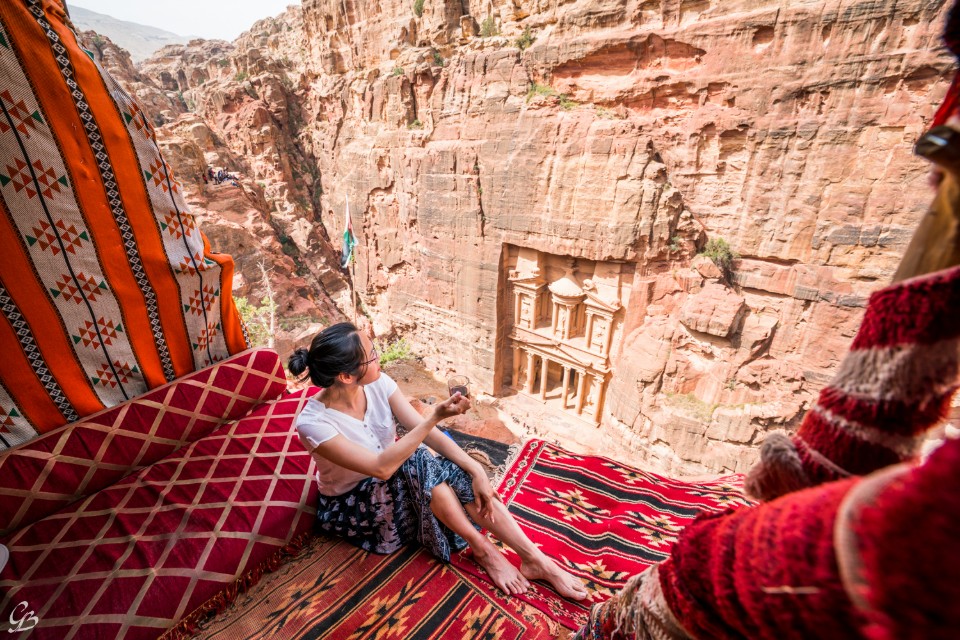
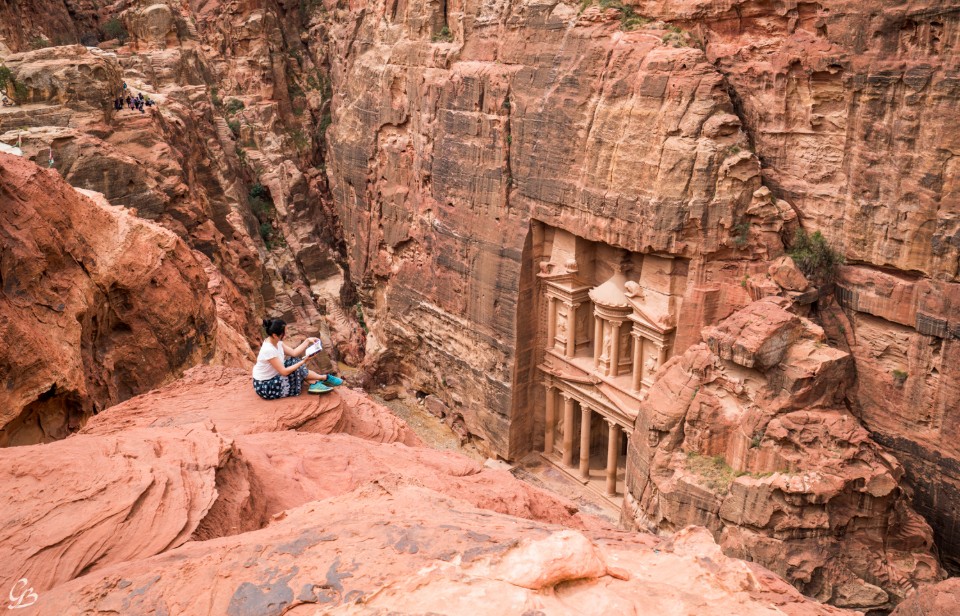
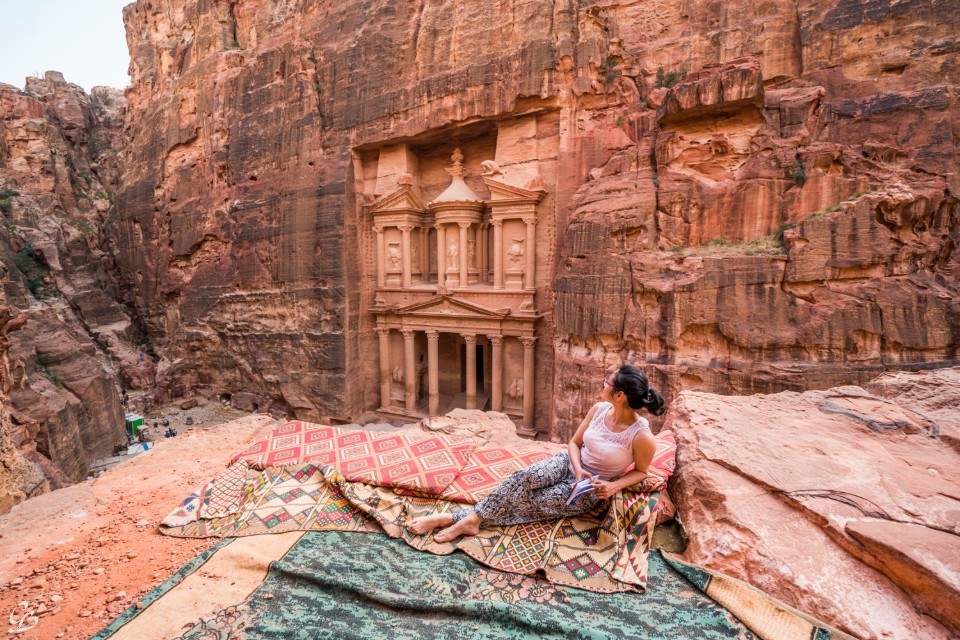
Petra itinerary: Recommended an itinerary for 2 days in Petra
Day 1
- Going Petra in the morning, admire Siq Canyon and Al-Khazneh (The Treasury) early in the morning.
- Hiking on the 2nd Al-Khubtha Trail, visit the royal tombs, reach the end of the trail, go to viewpoints 1 and 2.
- Afternoon: Follow the trail No. 4 Ad-Deir Trail, to Monastory (Ad-Deir).
Day 2
- In the morning, take the trail No. 3 High Place of Sacrifice Trail, to High Place of Sacrifice to enjoy the panoramic view from the highest viewpoint of Petra.
- Afternoon, visit the ruins (monastery, temple, tomb, theater) in the center of Petra on the main road.
- Go to viewpoint number 3 before saying goodbye to Petra.
Some best day tours, trips, activities and transfer services, tickets in, from and to Jordan, Petra, Amman you can refer to
- Amman: Petra, Wadi Rum, and Dead Sea 2-Day Tour
- From Amman: Petra, Wadi Rum and Dead Sea 3-Day Tour
- From Tel Aviv: Petra 2-Day Tour
- From Amman: Jerash, Ajloun Castle or Umm Qais Private Tour
- From Amman: Private Day Trip to Petra with Pickup
- Petra and Wadi Rum: 3-Day Guided Tour from Tel Aviv
- From Amman: Dead Sea and Madaba Tour with Hotel Pickup
- Transfer from QAIA to Amman (& v.v.)
- Petra Full-Day Private Tour from Amman
- From Amman: Petra Private Tour
- Amman to Petra Half-Day Transfer
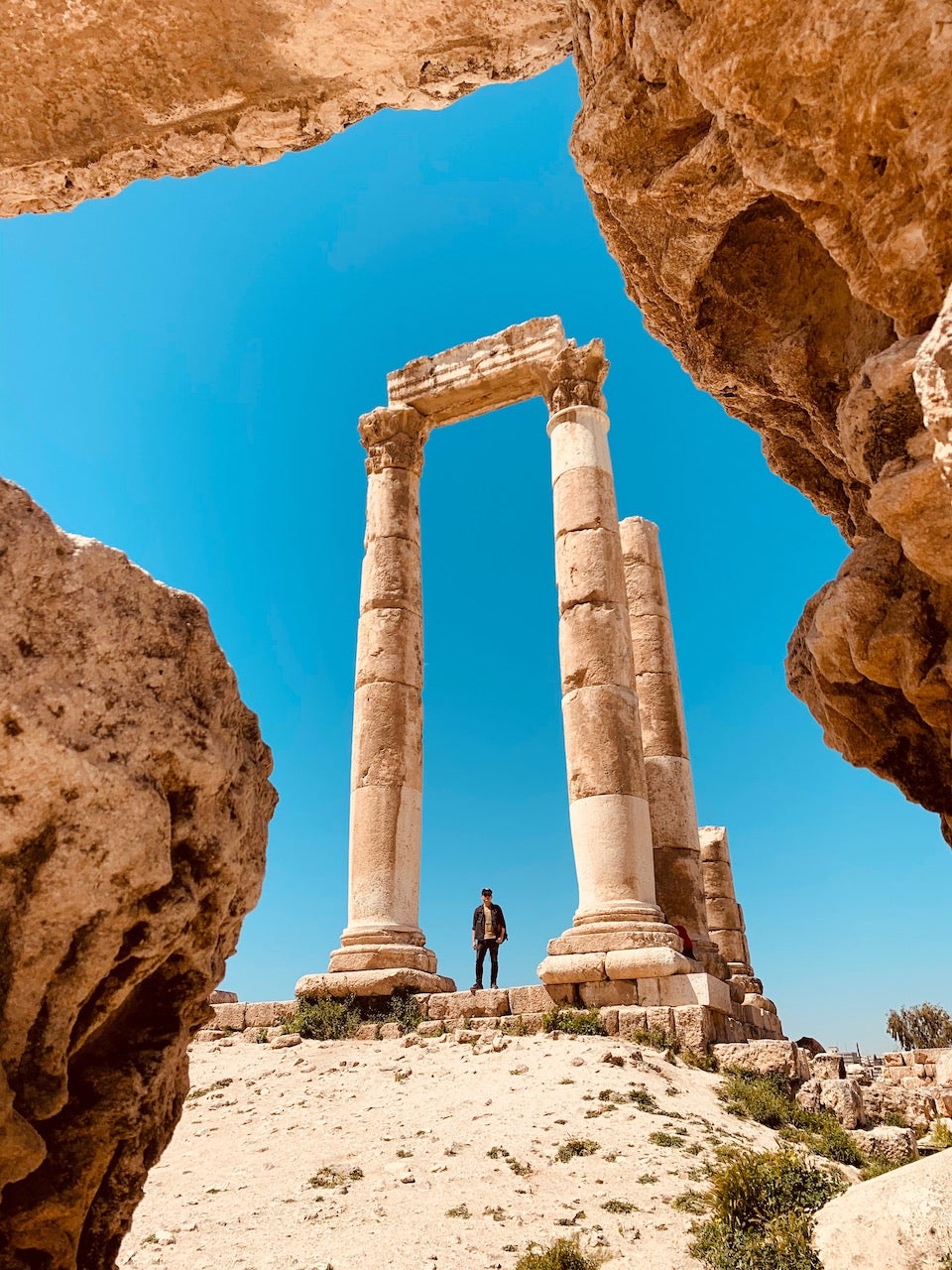
Read more Jordan travel guide here. And Wadi Rum guide here.































![10 best airports in Asia in 2016 [RANKED] kuala-lumpur-international-airport-best airports in asia in 2016 by skytrax ratings](https://livingnomads.com/wp-content/uploads/2016/08/29/kuala-lumpur-international-airport-best-airports-in-asia-in-2016-by-skytrax-ratings-218x150.jpg)








